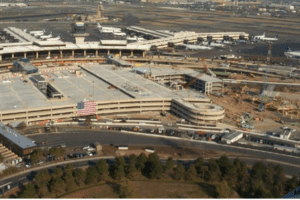
A United Airlines baggage handler was severely injured after a van crashed into an airplane tug, causing him to get stuck between the tug and a metal pillar. The van had swerved into the tug to avoid a truck that had veered across the center lane of the road. The truck had moved across the center lane to avoid colliding with the tug. Davis, Saperstein & Salomon, P.C. Partner Samuel L. Davis proved that the Port Authority of New York and New Jersey and the two contracted airport companies had been negligent in their failure to make a safe environment for their employees, securing our client and his family a $1.8 million dollar settlement.
The van, truck, and baggage handler were all on a restricted vehicle service road (RVSR) in Terminal C of Newark International Airport in Newark, New Jersey. RVSRs are roadways meant only for airport vehicles, such as vehicles shuttling passengers. The van was driving west on the RVSR while the truck was traveling east. The truck first swerved across the center lane to avoid an airplane tug, which was blocking a part of the road. Because the truck swerved into the lane, the van swerved also, colliding into the tug. The client was standing between the tug and a metal pillar. When the van collided with the tug, our client’s right leg was forcefully pinned between the pillar and the tug itself.
MIC-5, the unit assigned to provide 24-hour coverage for all EMS needs and requests in the New York and New Jersey Port Authorities, took the man by ambulance to University Hospital in Newark, New Jersey.
Our client suffered severe injuries to his pelvis and both of his legs. He suffered an open book pelvis ring fracture, or a shattered pelvis, and fractures in both of his femurs. He also sustained a lateral meniscus tear in his right knee and a patellar rupture in his left knee. To treat his pelvis, the man underwent several open reduction and internal fixation (ORIF) procedures. His two femur fractures required fixation with instrumentation, and his patellar tendon required surgical repair. The man relied on a ventilator for twelve days after the accident, and he spent several weeks in an inpatient rehabilitation facility after his surgeries.
Davis, Saperstein & Salomon, P.C. hired medical experts to author narrative reports and provide proof of the extent of our client’s pain and suffering. Their reports helped show our client was entitled to proper financial compensation for his loss of income, medical bills, and pain and suffering.
Davis, Saperstein & Salomon, P.C. Partner Samuel L. Davis sued the Port Authority of New York and New Jersey and their two contracted service companies in the Superior Court of New Jersey, Essex County, which resulted in a mediation trial settlement.
Medical Glossary
Femur: The femur is also known as the thighbone. It is the longest, strongest bone in the body, and is needed for someone to be able to stand. The femur supports many muscles, ligaments, and tendons.
Lateral Meniscus Tear: The lateral meniscus is the crescent-shaped cartilage located on the outer side of the knee. It connects the knee to the tibia (shin bone), and is useful as a shock absorber between the femur and tibia. A torn meniscus is a really common injury that usually happens after a sudden twist or rotation of the knee.
Open Book Pelvis Ring Fracture: A break in one of the bones belonging to the ring that forms the pelvis.
Open Reduction and Internal Fixation (ORIF): A surgical procedure in which the pieces of a broken bone are repositioned, realigned, and held together with screws, plates, sutures, or rods.
Patellar Tendon: A complete tear of the patellar tendon, the tendon that runs from the kneecap to the tibial tubercle. The tibial tubercle is the bony bump on the upper part of the shin. The patellar tendon attaches the quadriceps muscles to the tibial tubercle.
Pelvis: The large boney structure that attaches your legs to the base of your spine.
